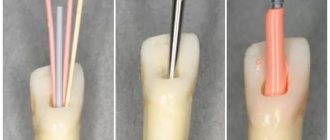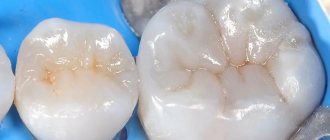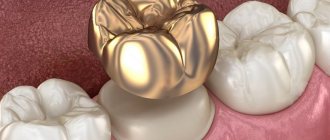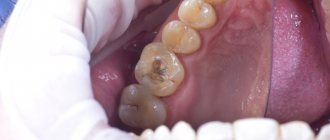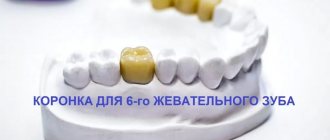Every day, the dentists of our clinic answer questions from their patients and people they consult on the Internet. Often, questions take the form of a complaint about other dentists and most often complain that the tooth hurts after treatment. Indeed, there are objective reasons why a tooth hurts after filling. We will try to help you figure out what could be the cause of the pain and what to do if you find yourself in such a situation.
The cause of tooth pain after treatment depends on the manipulations performed on the tooth. We have divided the large topic of pain after dental treatment into the following subtopics:
1. A tooth hurts after filling, that is, after caries treatment (this article);
2. Tooth hurts after nerve removal and canal cleaning;
3. The tooth under the crown hurts.
This article will discuss pain after caries treatment.
Stages and technology
Those barbaric times have long been forgotten when the only way to deal with a bad tooth was to remove it. Progress does not stand still, and perhaps in a few years scientists will come up with some non-contact methods for eliminating damage, however, at the moment, the main treatment for caries is dental filling. Moreover, the better the quality of the material and the more professional the doctor, the longer the damaged tooth will live.
Of course, with such an intervention in the body as filling, pain is simply inevitable, because the nerve endings located in the pulp instantly transmit a signal to the brain about the doctor’s manipulations. Even twenty years ago, dentists used painkillers only in the most extreme cases, which completely turned people away from the desire to treat caries in a timely manner. It was painful, unpleasant and terribly scary. Today, doctors at dental clinics can offer a huge range of anesthetics to choose from, thanks to which the treatment will be painless and unnoticeable.
The filling technology itself consists of several main stages and takes, on average, from half an hour to an hour:
- An injection of an anesthetic that relieves any pain.
- Thorough treatment and cleaning of areas of the tooth affected by caries. In case of pulpitis, the inflamed pulp is also removed and the tooth cavity is completely disinfected. If microscopic areas of the affected tissue remain under the filling, the inflammatory process will begin again with a vengeance.
- If the damage to the tooth surface is not very severe, a simple medical spacer is installed; otherwise, when filling teeth, the treatment technology will include the installation of pins.
- Depending on the location of the damaged tooth and other important factors, the doctor selects the material from which the filling is subsequently installed.
- In order to make sure that the work is done well, as well as that the affected areas are completely eliminated, the doctor takes an x-ray.
- The final stage of the work is grinding the filling composite to eliminate discomfort and coating the filling with indelible varnish. If the grinding is not carried out thoroughly, the patient may have problems chewing food and closing the jaw.
There are situations when the standard stages of tooth filling are not suitable for treating the affected area (canal curvature, filling with a pin and inlay, resection of the root apex). In such cases, so-called retrograde filling is used to prevent further inflammation and hermetically close the canals.
Indications
The cavity located inside the tooth, where the nerve endings and blood vessels are located, is called the pulp. If the caries lesion is not treated in a timely manner, the pathology reaches the pulp, which leads to the occurrence of an inflammatory process called pulpitis. The process does not go away on its own; the pain that inevitably arises is removed by painkillers in the initial stages. Over time, they also stop working. In advanced cases, inflammation spreads to the bone, which leads to periodontitis and, as a consequence, osteomyelitis. The main indication for root canal filling is pulpitis caused by caries.
Materials
In modern dentistry, a wide variety of materials are used for filling teeth. Since the purpose of filling is not only to close the hole in the tooth, but also to restore its physiological and anatomical functions, the material must be selected according to the load on the tooth and its location.
For example, in case of serious damage to the structure of the chewing tooth, polymers that can withstand heavy loads are used as a filling substance, and for the front teeth it is customary to use light-curing composites, since their properties help to match the color of the filling to the natural color. At the same time, silicophosphate or silicate cements are most often used for incisors.
The basic requirements for materials used to fill canals are as follows:
- complete sealing of root canals;
- absence of a chemical reaction that changes the color of the tooth;
- no shrinkage of the filling;
- easy removal from the dental cavity if repeated treatment is necessary;
- insolubility in the soft tissues of the tooth.
Gutta-percha meets most of the requirements from this list, but has one significant drawback, namely the complete inability of the material to block the vital activity of microorganisms in the sealed cavity. Glass ionomer cements, on the contrary, prevent this process. Not only are they particularly durable, but they are also fully compatible with dental tissues, release fluorides that help strengthen dentin, and do not shrink. When using this material, filling teeth has minimal consequences, however, it also has its drawback - increased acidity. In connection with this fact, a special calcium-based medical pad should be installed under such a filling.
There are other types of filling materials such as pastes, plastics and amalgam. Modern dentistry is trying to avoid the use of amalgam fillings, since they contain mercury, which is very harmful to the body; moreover, this material is not wear-resistant and very unreliable.
Aesthetic correction
You will be interested in: How to strengthen teeth if they are decaying: causes of dental structure damage, effective methods and advice from dentists
Does it hurt to put a filling on a tooth? Many do not believe that this can be endured easily and calmly. They are even more surprised when they find out that sometimes they fill a tooth without caries or pulpitis. This is necessary when you need to make an aesthetic correction. We are talking mainly about the front teeth, the edges of which have been slightly worn out or chipped off. This procedure is also performed if there is a spot of fluorosis. In order not to sacrifice a healthy tooth and not install a crown, they choose a simpler option - restoration with a filling.
Is it painful to have a filling?
Many readers remember very well from their own bitter experience how toothache was treated in Soviet times. Modern medicine has made giant leaps forward. So, knowing how teeth are filled now, we are no longer so afraid of going to the dentist. This is why the number of people suffering from toothache who are terrified of sitting in the doctor’s chair has been rapidly decreasing in recent years.
Nowadays, a patient in a good clinic is not even faced with the choice of treating a diseased tooth without or with anesthesia, and the choice of anesthetics is so wide that even an allergy sufferer will not have to suffer from pain. A couple of injections into the gums, and for quite a long time the patient does not experience any pain, and a slight sensitivity after filling, which usually goes away within a maximum of two days, can be relieved by modern painkillers or traditional medicine.
Anesthesia
Is it painful to get a filling in a tooth? There are people who, even after being convinced that this is quite tolerable, continue to be afraid. In the dentist's chair, they are overcome with horror at the sight of a syringe with an anesthetic. To minimize patient stress, dentists treat the injection site with an anesthetic cooling gel. But even without it, a qualified doctor performs the injection almost imperceptibly.
Features of filling anterior teeth
Caries of the front teeth is by no means a rare occurrence. The reasons may be poor nutrition, heredity, and lack of proper care. Typically, such caries is a small dark spot, usually on the inside of a tooth or between two teeth, which is even difficult to notice. However, since the dentin layer in the front teeth is very small, such a spot grows rapidly. The main thing is not to miss the moment while the teeth are still amenable to treatment.
When it comes to filling the front teeth, the aesthetic characteristics of the filling substance are placed above the functional ones, since the front teeth bear minimal load during the process of chewing food. That is why light-curing fillings are most often used to treat this type of caries, allowing the natural shape and shade of the enamel to be restored.
There is also a more advanced and expensive way to restore front teeth - ceramic fillings. Outwardly, they do not stand out in any way, so even up close it will be difficult to understand that you are looking at a filling. This material is much more resistant to external influences. True, making a filling from an impression takes quite a lot of time, so this method is usually used only in cases where the tooth is severely damaged and the use of a conventional light filling is impractical.
What determines the duration of treatment
Even if the nerve is alive and the tooth does not need to be depulped, treatment can be long. Its duration depends on the volume of tissue affected by caries. It happens that a carious cavity develops in several areas of the tooth at once, for example, on the chewing surface and the side wall. Then the doctor is forced to form cavities for several fillings.
Also, the restoration itself takes a lot of time, when the specialist tries to give the tooth such a shape and color that it is indistinguishable from healthy ones. How long does this recovery take? You can drill out the rotten part quite quickly - in 5-10 minutes. It may take half an hour or an hour to recreate the shape of a damaged tooth.
Pastes for filling
Often, when filling dental canals, a variety of pastes are used. This is one of the filling methods necessary to seal tooth voids after removal of the inflamed pulp. Currently, there are three types of pastes that are most popular; let’s look at their pros and cons.
| Endamethozon paste | One of the best, because it does not dissolve, does not dissolve, does not irritate tooth tissue and remains unchanged. The powder for making this paste comes in two colors: ivory and pinkish-orange. The latter is less preferable because it changes the color of the enamel over time. |
| Forfenan paste | During polymerization, it becomes very hot and releases formaldehyde, which turns the pulp into a solid, antiseptic substance. The only negative point in using this type of paste is the long hardening process. |
| Formalin paste Resorcinol | The disadvantage of this substance is its effect on tooth color. Over the years, the natural color changes to a completely unattractive appearance, so it is not recommended to use it on the front teeth. However, the use of this paste is quite widespread and has been proven over the years. |
There are also general disadvantages of all types of pastes: it is quite difficult to unfill a tooth during repeated treatment, the density of the material when filling the canal is distributed unevenly, and there is a high risk of air gaps forming in the hardened paste. And, nevertheless, filling tooth cavities with paste remains the most popular today.
Description of the procedure
- Local snapshot. X-ray allows you to see the condition of all channels, their number, location. In difficult cases, a 3D image is taken.
- Anesthesia.
- Drilling of diseased tooth tissues.
- Removal of nerve and blood vessels.
- Determining the depth of the canal using an apexolator.
- Widening the passage to place the drug and install the pin (if required).
- Filling.
- Control photo.
After treatment, it is not recommended to consume hot drinks and food for 1 – 2 hours.
How to behave at a reception
A good dentist always explains the treatment plan to his patient. Feel free to ask the doctor all the questions that concern you. The doctor will only be happy if he sees your interest in the results. Be clear with your dentist about what you want to get out of your treatment.
Explain to the doctor what exactly you are afraid of. A good specialist will always try to dispel your fears with detailed explanations and will do everything in his power to keep the patient calm. If you have already trusted the doctor, follow all his recommendations.
Does it hurt to put a filling on a tooth? Feedback from patients shows that this is not the only issue that concerns them. Mild pain in a recently filled tooth, which sometimes appears from hot and cold drinks, also causes concern. This reaction is explained by the fact that the photopolymer material has a fairly high thermal conductivity. As a rule, dentists advise you to wait a little. Over time, everything will return to normal. If pain occurs from acid, this means that the filling is not tight enough. In this case, be sure to consult a doctor.
Source
Treatment process
As already mentioned, in case of caries the nerve is preserved and the canals are not filled. Let's consider what stages there are in the process of treating a tooth with caries.
Does it hurt to put a filling on a tooth? Of course not! Before starting treatment, the doctor must give an anesthetic injection. When the anesthetic begins to act, a special material, a rubber dam, is placed on the tooth. This is a thin stretchable film. It fits the tooth so tightly that it prevents saliva and other liquids from getting on it. If you do not use this material, the filling may soon fall out.
The doctor uses a bur to drill out the rotten part of the tooth, forms a cavity, and lubricates it with a special solution (etchant). It is needed to improve the bond between the filling and the tooth. When the etching has taken effect, it is washed off and fluoride varnish is applied to the tooth. It strengthens tissues and reduces sensitivity.
Next, another substance is applied to the damaged tissue - bonding. It is needed to bind the filling and tooth, but unlike etching, bonding is able to penetrate into the dentinal tubules. In order for the substance to act and harden, a helium lamp is shined on it. It's completely safe.
Does it hurt to put a filling on a tooth? No, this procedure is completely unpleasant, but completely painless. To make a filling, the dentist uses not one, but several types of photopolymer material. The fact is that different layers of the tooth differ in color and transparency. After applying filling material to each of them, the doctor illuminates it to harden it.
To make a tooth with a filling look natural, the dentist artificially creates mamelons on its surface. This is a slightly noticeable longitudinal ribbing. If a chewing (back) tooth is being restored, the doctor recreates the grooves between its cusps.
At the final stage, the doctor grinds the tooth. This is necessary to ensure that its surface is smooth. Then plaque will not stick to it. To find out if the filling is too high, the doctor asks the patient to knock (chew) his teeth, placing special paper between them. It is similar to carbon paper because it retains the imprints of all the irregularities. It is with them that the dentist checks whether the filling is too high. If necessary, he corrects it. If this check is not done, the patient will find it uncomfortable to chew. This will affect your bite.
Does it hurt to put a filling on a tooth? At any stage, as you can see, it is completely painless.
What is a filling [1,2]
A dental filling is a structure made of plastic and hardening components that fills a cavity formed in a tooth as a result of pathological processes. It is placed in order to cover the tissue exposed during the removal of carious or dead elements, as well as to prevent food and pathogens from entering the tooth, into the canals, and onto the bone tissue. In addition, the filling replenishes lost tissue and restores the anatomical shape of the tooth, chewing and aesthetic functions.
There are many reasons why a cavity forms:
- pulpitis ;—inflammation of the soft tissues inside the tooth;
- periodontitis is an infectious and inflammatory disease of the ligaments that hold the tooth in the jaw bone;
- caries that has spread to the middle or deep layers;
- injuries, chips, cracks and other physical and mechanical damage to the integrity of the tooth;
- non-carious lesions of teeth, for example, a wedge-shaped defect due to mechanical abrasion of the enamel.
